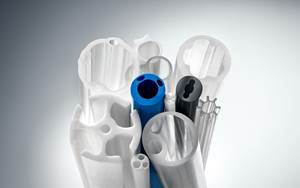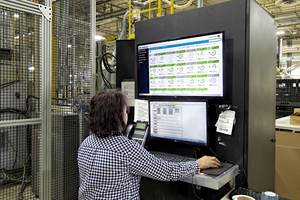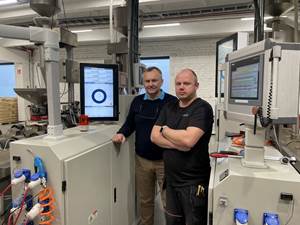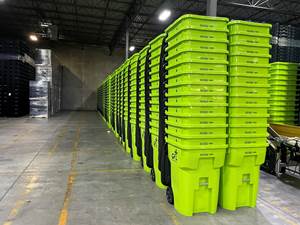Thermoforming Helps Harvest the Wind
It was a decades-old relationship that led to the development of an exciting new application for twin-sheet thermoforming.
Apparently it pays to be memorable in high school after all. It was a decades-old relationship between George Lawton, an engineer for Kintz Plastics, and a member of the design team at Optiwind that led to the development of an exciting new application for twin-sheet thermoforming: a cover for the vertical surfaces on Optiwind’s wind turbines.
Kintz Plastics Inc., in the upstate New York town of Howes Cave, has been an industry leader in thick-gauge thermoforming since it opened in 1976. The family-owned company uses vacuum forming, pressure forming, and twin-sheet forming to supply covers, bezels, and housings for applications ranging from biomedical equipment like blood-analysis machines to air-conditioned pet carriers to drainage and storm-water projects.
With annual sales in the range of $10 million to $15 million and more than 100 employees, Kintz’s plant includes a 30,000-ft² Technology Center that integrates design and engineering departments. The thermoformer’s 35 years of experience in materials, processing, part and tool design (Kintz guarantees its molds for the life of the project), painting, and screen printing, have helped it get involved in projects early in the design phase. Kintz’s ability to work with customers on a soup-to-nuts basis comes in handy when an altogether new project heads it way.
“We didn’t know Optiwind, nor about the possible application, until they came to us about 18 months ago,” recalls Wynn Kintz, CEO. “But one of their guys went to high school with George, and things progressed from there.”
The project has required several tooling iterations. The tool itself weighs more than a ton. “That whole process was a collaborative effort between their team of designers and our engineering/design group,” states Kintz. “Lots of meetings, lots of drawings, lots of modifications, none of which is surprising on a new application.”
The part is made up of numerous HDPE cones that are formed into the sheet. The complete part stands 66 in. wide x 105 in. tall, representing one of the largest Kintz has produced. The parts are formed on rotary thermoformers from Maac Machinery Corp., Carol Stream, Ill. “There aren’t many thermoformers capable of producing a part this complicated and this large,” Kintz says. “The sheet is only 0.062-in. thick, and the window to get all the different parts to bond is very narrow.”
The Optiwind turbines themselves are a shade under 200-ft tall and require a cover that is lightweight but strong enough to withstand wind and weather. “Twin-sheet thermoforming was key to the design of the wind turbine,” says David Hurwitt, marketing v.p. for Optiwind in Torrington, Conn.
The Optiwind turbines are designed for mid-size applications, such as schools, hotels, retailers, farms, and municipalities. They are said to be more compact and quieter than traditional turbine designs and are built right on the site of the energy consumer. The first test turbine with the Kintz cover was installed at a farm in Torrington last year. A full-scale commercial launch is planned for 2011.
Kintz expects to produce thousands of parts a year for the project (roughly 250 parts go into each turbine). The covers are interchangeable on Optiwind turbines of different sizes.
Related Content
Medical Manufacturer Innovates with Additive Manufacturing and Extrusion Technology Hubs
Spectrum Plastics Group offers customers two technology hubs — one for extrusion, the other for additive manufacturing — to help bring ground-breaking products to market faster.
Read MoreNew CRM Streamlines Quoting for Automotive Molder
Eliminating the need to contact each supplier for every individual quote, a new CRM for automotive supplier Axiom Group tracks past quotes as well as industry history to generate fast, reliable RFQs and more.
Read MoreOnline X-Ray Inspection Boosts Extrusion Quality
Höhle uses Sikora’s x-ray measuring systems for inline quality control of extruded microducts.
Read MoreInjection Molder Changes Up Color Changes
An injection molder of trash cans, pallets, totes and other plus-size components, Rehrig Pacific’s machine fleet is composed of larger tonnage presses whose size makes material changes at the feed throat a potentially dizzying exercise.
Read MoreRead Next
Making the Circular Economy a Reality
Driven by brand owner demands and new worldwide legislation, the entire supply chain is working toward the shift to circularity, with some evidence the circular economy has already begun.
Read MoreBeyond Prototypes: 8 Ways the Plastics Industry Is Using 3D Printing
Plastics processors are finding applications for 3D printing around the plant and across the supply chain. Here are 8 examples to look for at NPE2024.
Read More













